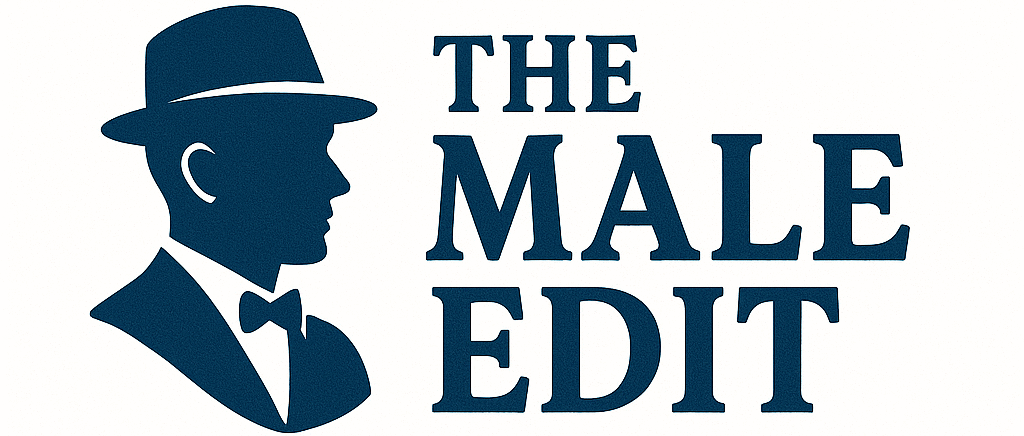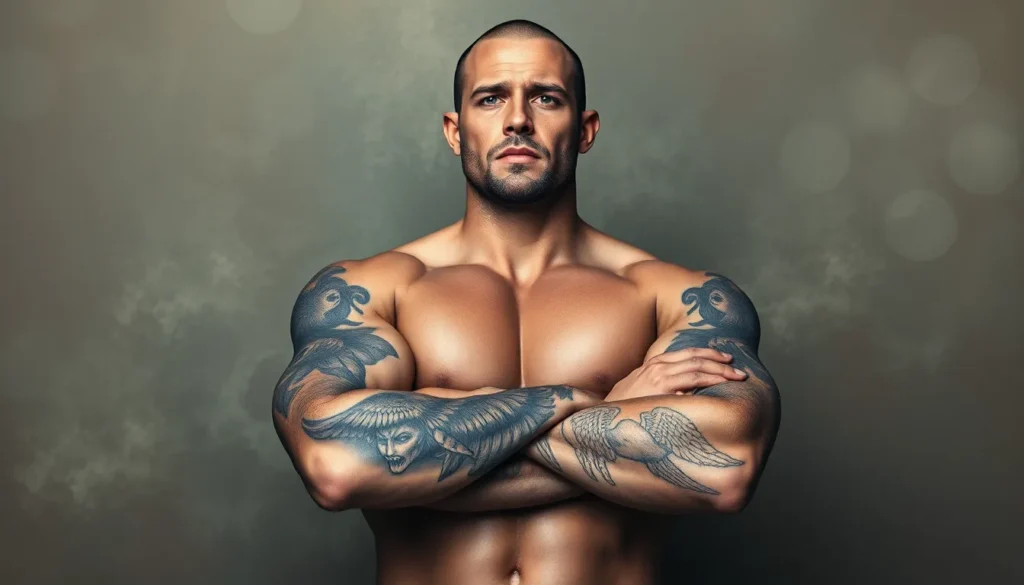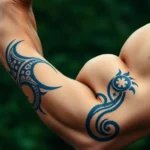The eternal battle between light and darkness has captivated humanity for centuries and now it’s making a powerful statement on men’s skin through striking good and evil tattoos. These designs represent the complex duality that exists within every person – the constant struggle between our better angels and darker impulses that defines the human experience.
We’ve seen an incredible surge in men choosing these symbolic tattoos to express their personal journey and philosophical beliefs. From classic angel and demon combinations to modern interpretations featuring yin-yang elements these designs offer endless creative possibilities for meaningful body art.
Whether you’re drawn to bold contrasting imagery or subtle symbolic representations good and evil tattoos provide a compelling way to showcase your understanding of life’s complexities. We’ll explore the most popular design concepts placement ideas and artistic styles that make these tattoos truly unforgettable pieces of personal expression.
Understanding the Symbolism Behind Good and Evil Tattoo Designs for Men
These powerful tattoo concepts draw from centuries of human storytelling and philosophical exploration. Men gravitate toward these designs because they represent the fundamental conflicts we all face within ourselves.
The Duality of Human Nature
Good and evil tattoos represent the constant battle between our higher selves and our darker impulses. We see this internal conflict reflected in countless design choices that men make when selecting these symbolic pieces. Every person carries both light and shadow within their character, making these tattoos deeply relatable on a personal level.
Men often choose these designs to acknowledge their own complexity rather than pretending perfection exists. The tattoos serve as reminders that growth comes from understanding and accepting all aspects of ourselves. We find that many clients use these pieces to mark important life transitions where they’ve confronted their own moral challenges.
Psychology suggests that acknowledging our dual nature leads to better self awareness and emotional maturity. These tattoos become visual representations of that journey toward wholeness. Men frequently report feeling more authentic after getting designs that honor both their struggles and their aspirations.
Cultural and Religious Interpretations
Christianity presents one of the most recognizable frameworks for good versus evil imagery in tattoo art. We see angels battling demons, crosses opposing inverted symbols, and biblical scenes depicting moral conflicts. These designs often incorporate elements like halos, wings, pitchforks, and flames to clearly distinguish between divine and demonic forces.
Eastern philosophies offer the yin yang symbol as a perfect representation of balanced duality. Buddhism and Taoism teach that opposing forces complement rather than compete with each other. Men drawn to these interpretations often choose designs featuring complementary elements like lotus flowers emerging from dark water or tigers paired with dragons.
Indigenous cultures worldwide have their own interpretations of moral duality that influence modern tattoo designs. Native American traditions speak of the struggle between the wolf you feed, while Celtic mythology presents light and dark gods in eternal conflict. We notice increasing interest in these cultural symbols among men seeking alternatives to Western religious imagery.
Popular Mythological References
Greek mythology provides rich material for good and evil tattoo designs through stories of gods and titans. We see Apollo representing light and order contrasted with darker deities like Hades ruling the underworld. Perseus slaying Medusa remains a popular choice for men wanting to symbolize triumph over evil forces.
Norse mythology offers compelling duality through figures like Odin, who embodies both wisdom and warfare. The eternal battle of Ragnarok represents the cyclical nature of destruction and renewal that resonates with many men. We find that Thor’s hammer paired with Loki’s serpent creates powerful visual contrast in tattoo compositions.
Egyptian mythology presents the eternal struggle between Ra and Apep, light conquering darkness each dawn. The Eye of Horus protecting against the forces of chaos appeals to men seeking protection symbolism. We observe that ankh symbols representing life often appear alongside scarab beetles symbolizing death and rebirth in these designs.
Angel and Demon Wing Tattoos: Classic Good and Evil Representations
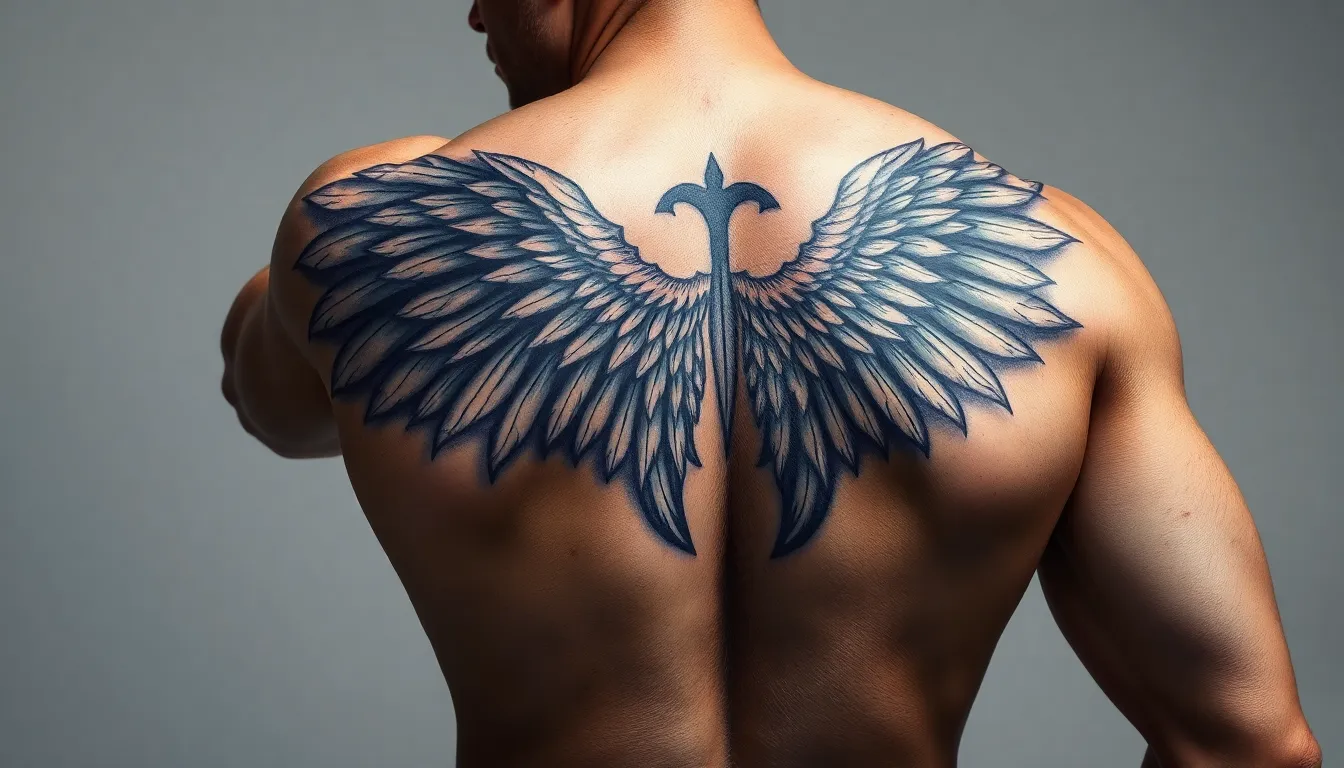
Angel and demon wing tattoos perfectly capture the eternal struggle between light and darkness that resonates deeply with men seeking meaningful body art. These designs represent one of the most recognizable symbols of moral duality in tattoo culture.
Traditional Angel Wing Designs
Traditional angel wing tattoos embody protection, purity, and divine guidance through their elegant symbolism. Soft, flowing lines characterize these designs, creating a sense of movement and grace that appeals to men seeking spiritual representation. Artists often incorporate these wings into black and grey realism styles, producing stunning depth and texture that brings the feathers to life.
Popular variations include single wings positioned on the shoulder blade, paired wings spanning the entire back, and smaller memorial wings placed over the heart. We see these designs frequently combined with religious symbols like crosses, halos, or biblical verses to enhance their spiritual meaning. The wings themselves can feature intricate feather detailing, subtle shading gradients, and sometimes incorporate elements like clouds or light rays to emphasize their heavenly nature.
Demonic Wing Variations
Demonic wing tattoos showcase the darker aspects of human nature through bold, aggressive imagery that commands attention. These designs feature sharp, angular lines and dramatic shadows that create an intimidating presence on the skin. Artists typically use darker color palettes including deep reds, blacks, and purples to emphasize the sinister nature of these wings.
Common elements in demonic wing designs include bat-like membranes, jagged edges, and torn or weathered appearances that suggest battle or corruption. We often observe these wings paired with skulls, flames, or other dark imagery to create comprehensive evil-themed compositions. The contrast between smooth skin and textured wing surfaces adds visual interest while reinforcing the chaotic nature these tattoos represent.
Many men choose to combine angel and demon wings in a single “Angel Demon” design, symbolizing the balance between good and evil within themselves. This powerful combination highlights personal struggles and the complexity of human morality.
Placement and Size Considerations
Placement decisions significantly impact the visual effect and meaning of angel and demon wing tattoos. The back provides the most popular canvas for these designs, offering ample space for detailed artwork that can span shoulder blade to shoulder blade. Upper arms serve as excellent locations for single wing designs, while the chest allows for dramatic presentations that frame the torso.
Size requirements vary based on the desired visual impact and available skin area. Larger tattoos measuring 8-12 inches create striking, detailed representations that showcase intricate feather work and shading techniques. Smaller designs measuring 4-6 inches offer subtle yet meaningful options for men preferring understated symbolism.
| Placement | Typical Size Range | Visual Impact |
|---|---|---|
| Full Back | 12-18 inches | Maximum dramatic effect |
| Upper Arms | 6-10 inches | Bold, visible statement |
| Chest | 8-14 inches | Intimate, personal meaning |
| Shoulder Blades | 4-8 inches | Balanced, proportional |
We recommend considering pain tolerance and healing time when selecting placement, as areas with more muscle and fat typically heal faster than bony regions. The chosen location should also complement your lifestyle and professional requirements while allowing the design to flow naturally with your body’s contours.
Yin Yang Inspired Good and Evil Tattoo Concepts for Men
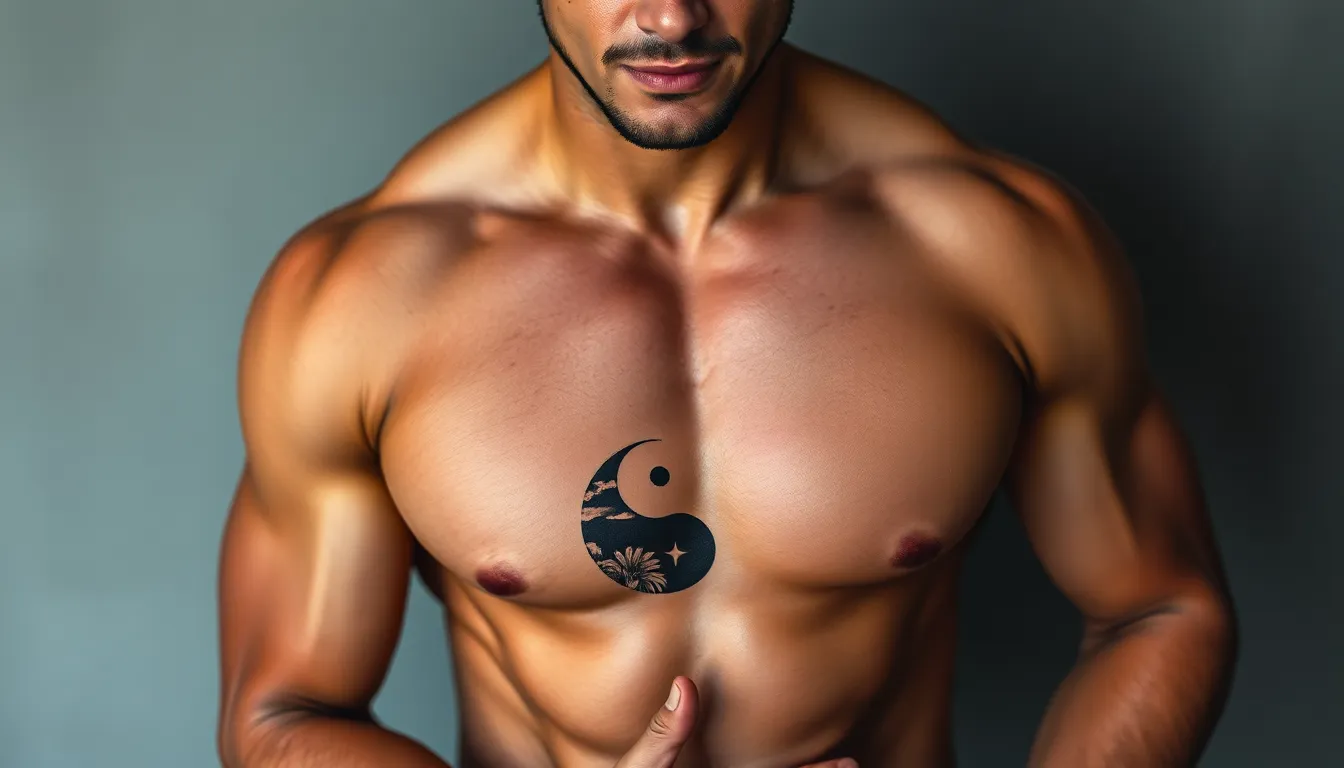
While angel and demon designs offer dramatic visual contrasts, yin yang tattoos provide a more nuanced approach to expressing the balance between good and evil. Eastern philosophy brings a sophisticated perspective to masculine tattoo artistry through this timeless symbol.
Traditional Yin Yang Symbolism
Traditional yin yang tattoos represent the unity of opposites through ancient Chinese philosophical principles. Originating thousands of years ago, this symbol features a circle divided by an S-shaped line into black and white halves, with each section containing a dot of the opposite color.
The dark yin symbolizes:
- Femininity and earth elements
- Darkness and passivity
- Introspective qualities
- Receptive energy
The light yang embodies:
- Masculinity and heaven elements
- Light and activity
- Expressive qualities
- Active energy
We find this design particularly meaningful because it illustrates that good and evil aren’t separate forces but interconnected parts of a whole. Rather than depicting conflict, the traditional yin yang shows how opposing forces continuously transform into each other, creating perfect balance and harmony.
Modern Interpretations and Variations
Contemporary yin yang tattoos for men frequently expand beyond the classic black and white design through creative artistic interpretations. Modern artists substitute animals like wolves and lions or mythic creatures such as dragons and phoenixes to represent duality in more ever-changing ways.
Popular modern variations include:
- Geometric patterns with sharp angular lines
- Monochromatic shading techniques for depth
- 3D effects that create visual dimension
- Abstract designs using flowing organic shapes
These adaptations allow men to maintain the core theme of balance while expressing personal style preferences. Geometric yin yang tattoos appeal to men who prefer clean, structured aesthetics, while organic flowing designs suit those drawn to natural forms and movement.
Incorporating Personal Elements
Personalization transforms standard yin yang designs into unique expressions of individual journeys and beliefs. Men increasingly add meaningful symbols, initials, important dates, or culturally important icons that merge seamlessly with the yin yang motif.
Common personalization elements include:
- Tribal patterns representing heritage
- Script or meaningful quotes
- Nature imagery like mountains, rivers, or stars
- Family symbols or initials
Cultural integration works particularly well with yin yang designs, as Eastern philosophical concepts blend naturally with other symbolic traditions. We see men combining Celtic knots, Norse runes, or Native American symbols to create tattoos that honor multiple aspects of their identity while maintaining the fundamental message of balanced duality.
Biblical Good and Evil Tattoo Ideas for Religious Men

Religious men often turn to biblical imagery when exploring the eternal struggle between good and evil through tattoo art. These designs carry deep spiritual significance while showcasing the timeless battle between light and darkness that resonates throughout Christian theology.
Heaven and Hell Imagery
Biblical tattoos depicting heaven and hell scenes offer powerful visual representations of the ultimate moral divide. Angels descending from celestial clouds contrast dramatically with demons emerging from fiery depths, creating compelling artwork that speaks to the soul’s eternal destination. Gates of heaven adorned with golden light and peaceful imagery stand in stark opposition to the dark, foreboding entrance to hell.
Popular designs include elaborate scenes showing the saved ascending toward paradise while the damned descend into torment. These tattoos often incorporate biblical elements like trumpets, harps, and divine light for heaven, while hell imagery features flames, chains, and shadowy figures. Many men choose full back pieces or sleeve designs to accommodate the intricate details these complex scenes require.
Archangel Michael vs. Lucifer Designs
Archangel Michael’s legendary battle against Lucifer represents the ultimate confrontation between good and evil in Christian tradition. These tattoos capture the dramatic moment when Michael, wielding his sword of righteousness, defeats the fallen angel in cosmic combat. The design typically shows Michael in radiant armor with powerful wings spread wide, standing triumphant over Lucifer’s defeated form.
Artists often emphasize the contrast between Michael’s divine light and Lucifer’s dark presence through careful shading and color choices. Wings play a crucial role in these designs, with Michael’s feathered wings representing purity while Lucifer’s bat like wings symbolize his fallen nature. These tattoos work exceptionally well as chest pieces or back tattoos where the full drama of the battle can unfold.
Cross and Serpent Combinations
Cross and serpent tattoos merge Christianity’s most sacred symbol with the biblical representation of temptation and evil. The cross stands as a beacon of redemption and salvation, while the serpent coiled around its base represents the ongoing struggle against sin and temptation. This combination creates a powerful visual narrative about overcoming evil through faith.
Design variations include serpents wrapped around wooden crosses, creating tension between the sacred and the profane. Some men choose designs where the serpent appears to be crushed beneath the cross, symbolizing Christ’s victory over sin and death. Others prefer more balanced compositions where the serpent and cross coexist, representing the daily battle between good and evil that every believer faces.
These tattoos often incorporate additional biblical elements like thorns, roses, or scripture verses to enhance their spiritual meaning. The contrast between the smooth, curved lines of the serpent and the rigid, geometric structure of the cross creates visually striking artwork that carries profound theological significance.
Skull and Halo Tattoo Combinations for the Modern Man

Skull and halo tattoos create a striking visual paradox that resonates deeply with men seeking to express their complex inner nature. These powerful combinations represent the duality between mortality and divinity, offering a contemporary approach to the timeless theme of good versus evil.
Life and Death Symbolism
Mortality takes center stage when we examine skull and halo combinations, where each element carries profound meaning. The skull represents death, mortality, and our earthly struggles, while the halo signifies purity, spiritual ascension, and divine grace. Together, they create a powerful narrative about the cycle of life and our journey between opposing forces.
Death imagery through skulls reminds us of our finite existence and the darker aspects of human nature. Spiritual ascension through halos connects us to higher purposes and our potential for goodness. The contrast becomes particularly meaningful when these elements intertwine in a single design, symbolizing how death and life coexist within our consciousness.
Transformation plays a key role in these designs, as many men choose skull and halo tattoos to mark important life changes or periods of spiritual growth. Redemption themes often emerge when the halo appears to be lifting the skull upward, suggesting the triumph of good over evil. The visual tension between these elements creates a compelling story of personal evolution and self-acceptance.
Gothic and Contemporary Styles
Gothic styling brings dark, intricate elements to skull and halo combinations through bold lines and minimal color palettes. Traditional gothic approaches feature heavy black work with detailed skull anatomy and ornate halo designs reminiscent of medieval religious art. These designs often incorporate crosses, thorns, or other symbols of mortality alongside the central skull and halo motif.
Contemporary interpretations blend modern tattoo techniques with classic symbolism, creating fresh takes on this timeless combination. Modern artists experiment with abstract elements, geometric patterns, and innovative color placement to give skull and halo tattoos a current aesthetic. The contemporary approach allows for more personal expression while maintaining the core symbolic meaning.
Artistic fusion between gothic and contemporary styles creates unique hybrid designs that appeal to diverse preferences. Some artists combine gothic linework with contemporary shading techniques, while others add modern elements like watercolor effects to traditional gothic compositions. This flexibility allows each tattoo to reflect the wearer’s personal style while honoring the symbolic significance of the design.
Color Schemes and Shading Techniques
Black and gray dominate traditional skull and halo tattoos, creating dramatic contrast that emphasizes the symbolic opposition between elements. Monochromatic approaches allow the intricate details of both skull anatomy and halo design to shine without color distractions. These classic color schemes work particularly well for gothic style interpretations, where shadows and highlights define the overall impact.
Vibrant colors transform contemporary skull and halo designs into eye-catching statements that challenge traditional expectations. Golden halos paired with naturally colored skulls create striking visual hierarchies that draw attention to the spiritual elements. Some modern designs incorporate blues, purples, or reds to add emotional depth and personal significance to the overall composition.
Realistic shading techniques add dimensional depth that makes skull and halo combinations appear three-dimensional on the skin. Stark contrasts between light and shadow enhance the symbolic struggle between good and evil forces. Advanced shading methods like stippling, cross-hatching, and gradient work create texture variations that bring both skulls and halos to life with remarkable detail and visual impact.
Good and Evil Portrait Tattoos: Split Face Designs
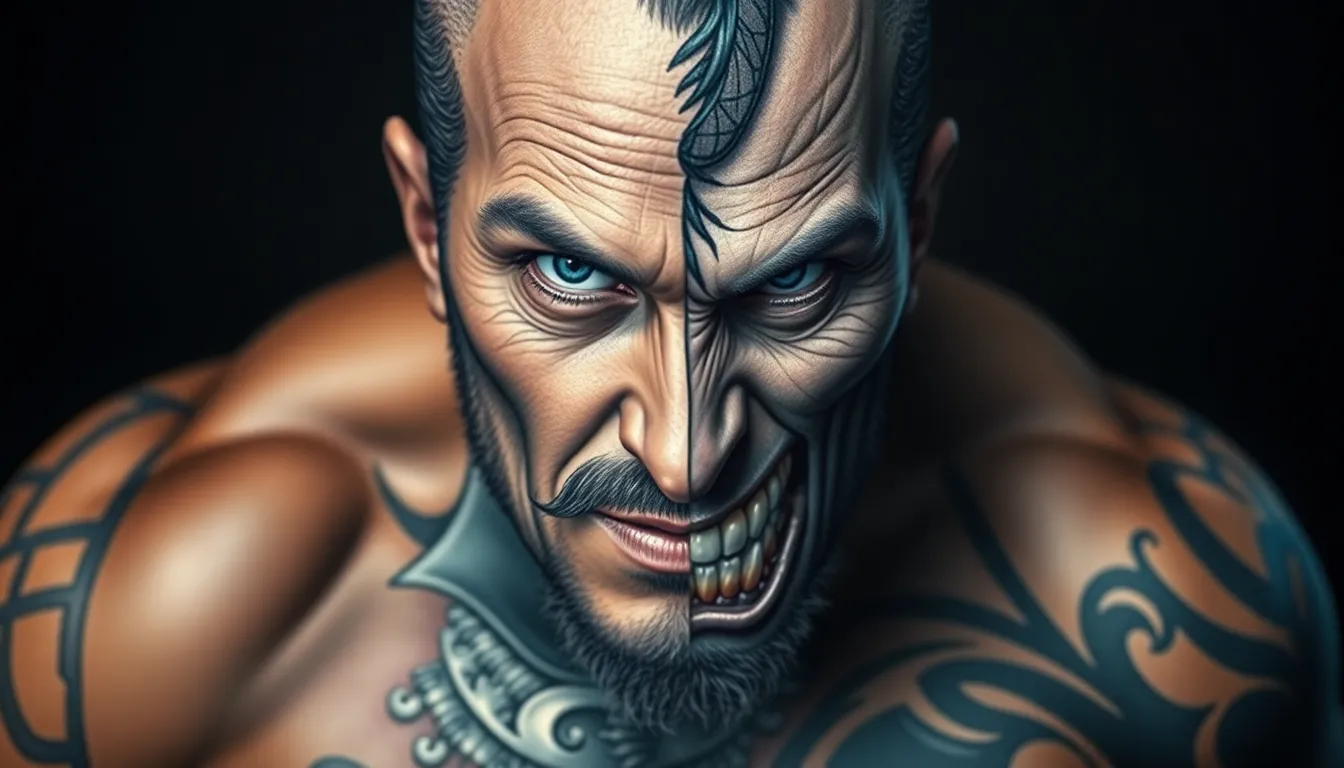
Split face tattoos offer a dramatic visual representation of moral duality that captures the eternal struggle between light and darkness. These designs typically feature half of a face depicting benevolent characteristics while the other half showcases malevolent traits, creating a powerful symbol of internal conflict.
Jekyll and Hyde Inspirations
Robert Louis Stevenson’s classic tale provides exceptional inspiration for dual personality themed tattoos that explore the coexistence of good and evil within one individual. These designs often feature a refined gentleman on one side transforming into a menacing figure on the other, symbolizing the hidden darkness that exists beneath civilized facades.
Transform your tattoo into a story of personal metamorphosis by incorporating elements like Victorian era clothing contrasted with wild, disheveled features. Many men choose these Jekyll and Hyde designs to represent their own internal battles and the groundbreaking journey toward self-acceptance. Services like Vondy and BlackInk AI offer customization options that help you perfect the contrast between civilized restraint and primal impulses in your design.
Consider adding symbolic elements such as a pocket watch on the Jekyll side transitioning to broken chains on the Hyde side to emphasize the theme of time and liberation from social constraints.
Warrior vs. Sage Concepts
Warrior and sage combinations create compelling contrasts between active strength and contemplative wisdom that represent different approaches to handling life’s challenges. One side typically features battle-worn armor, scars, and determined expressions while the other displays serene features, closed eyes, and peaceful countenance.
Balance becomes the central theme as these designs showcase how courage and wisdom must work together to achieve true strength. The warrior side might include elements like helmets, weapons, or tribal markings while the sage portion incorporates flowing robes, meditation beads, or ancient symbols of knowledge.
Emphasize the harmony between action and reflection by using connecting elements like shared facial features or flowing designs that bridge both sides. These tattoos work particularly well for men who’ve experienced military service or those pursuing spiritual growth while maintaining their fighting spirit.
Realistic vs. Stylized Approaches
Realistic portrait tattoos demand exceptional skill from artists who use detailed shading techniques to create lifelike depictions of good and evil figures with remarkable depth and dimension. These designs often feature photographic quality faces that seem to emerge from the skin itself, requiring multiple sessions and substantial investment.
Stylized interpretations offer more artistic freedom through bold lines, vibrant colors, and abstract elements that convey the good versus evil theme without strict adherence to realistic proportions. Comic book aesthetics, geometric patterns, and exaggerated features can create striking visual impact while maintaining the symbolic meaning.
Choose realistic approaches when you want maximum emotional impact and artistic prestige, especially for larger pieces on the back or chest. Opt for stylized versions when you prefer bold statement pieces that incorporate personal artistic preferences or cultural design elements that reflect your individual journey.
Animal-Based Good and Evil Tattoo Designs for Men
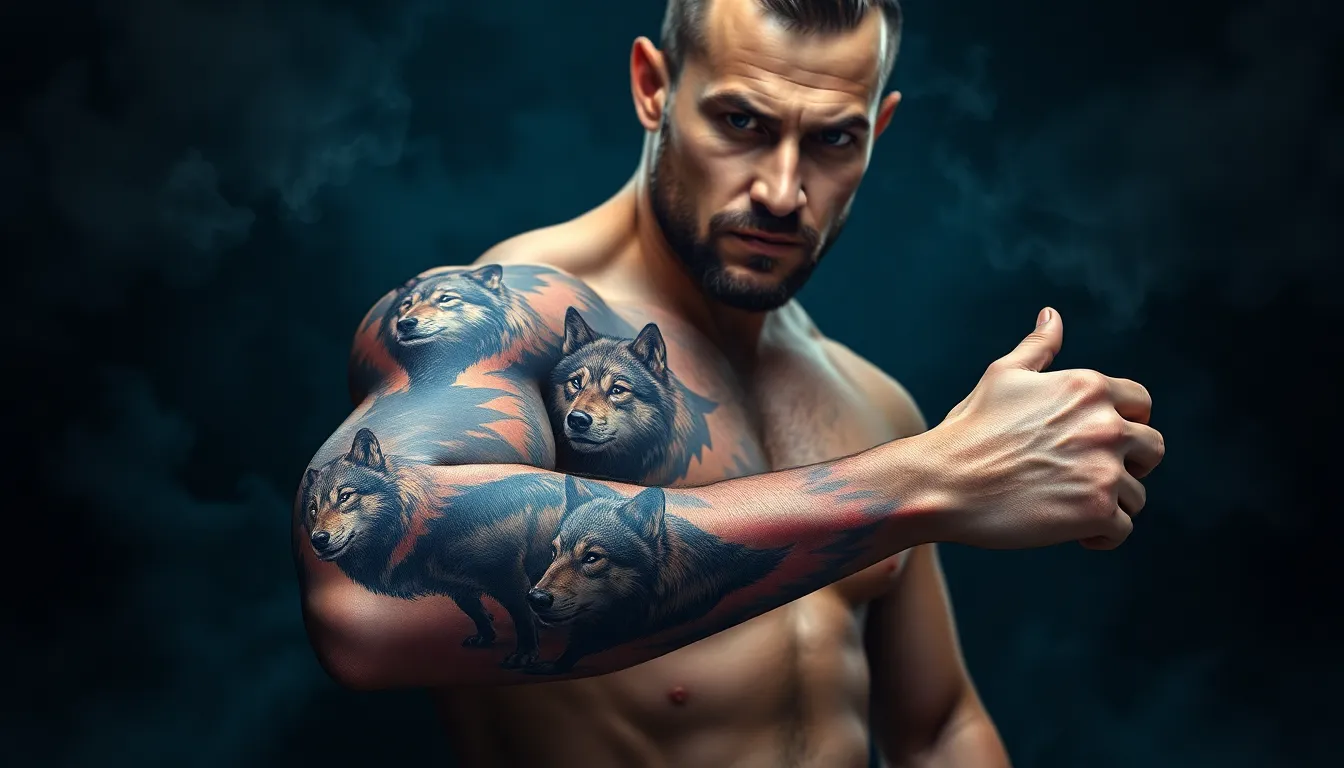
Animals provide powerful symbolism for expressing the eternal struggle between good and evil forces within us. These designs capture the primal nature of moral conflict through creatures that represent different aspects of human character.
Wolf Pack Dynamics
Wolf tattoos represent loyalty, strength, and teamwork while simultaneously embodying the darker aspects of human nature. These designs work exceptionally well for men who want to showcase the complex balance between protective instincts and destructive impulses. We often see wolf pack tattoos where some wolves appear in positive lighting while others emerge from shadowy backgrounds, creating a visual representation of internal moral conflict.
Pack dynamics allow for intricate storytelling within a single tattoo design. You can incorporate elements like skulls or dark atmospheric backgrounds to emphasize the evil aspects while maintaining the wolves’ inherent nobility. The contrast between the pack’s protective nature and their potential for violence creates compelling artwork that speaks to the duality of masculine strength.
Lion and Serpent Combinations
Lions symbolize courage and goodness, making them perfect counterparts to serpents that represent deceit and evil. This powerful combination creates visually striking tattoos that capture the eternal battle between righteousness and temptation. We recommend designs featuring a lion battling a serpent or a majestic lion with a serpent wrapped around its body to represent the ongoing struggle between these opposing forces.
The symbolism becomes even more meaningful when you consider the lion’s role as a protector versus the serpent’s reputation as a deceiver. These tattoos work particularly well on larger canvas areas like the back or chest, where the intricate details of both the lion’s mane and the serpent’s scales can be fully appreciated. Color choices often emphasize the contrast, with golden tones for the lion and darker hues for the serpent.
Eagle and Raven Symbolism
Eagles represent freedom and goodness, soaring above earthly concerns, while ravens symbolize mystery and sometimes ill omens. This combination creates fascinating tattoo designs that explore the balance between light and darkness in our lives. We’ve seen stunning pieces featuring an eagle soaring above a raven or both birds facing each other in a symbolic confrontation between opposing forces.
The design possibilities are endless with eagle and raven symbolism. You might choose a composition where the eagle’s wings spread wide in protective stance while the raven perches nearby, representing the constant presence of both positive and negative influences. These tattoos often incorporate dramatic sky backgrounds or storm clouds to enhance the symbolic meaning of the eternal struggle between good and evil.
Japanese Good and Evil Tattoo Styles: Oni and Tengu Themes
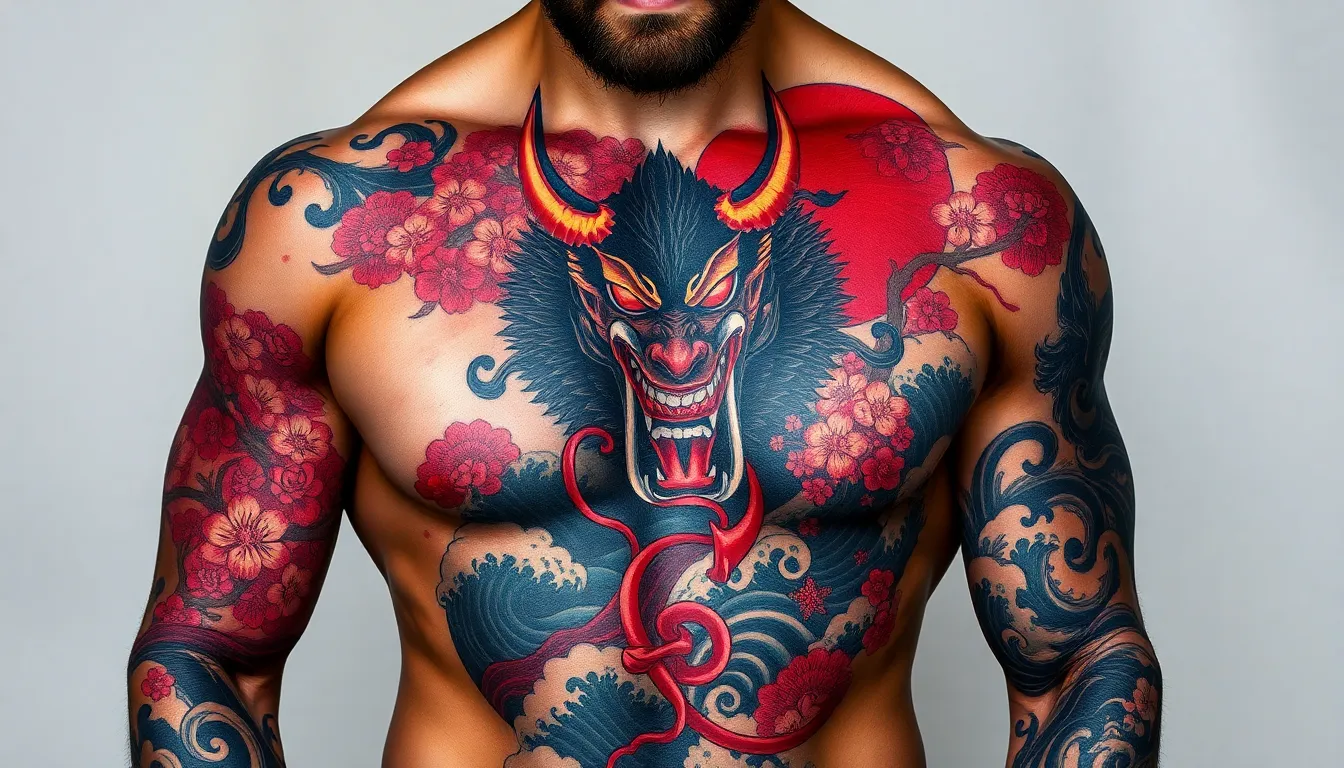
Japanese tattoo artistry offers some of the most compelling interpretations of good and evil through supernatural beings and protective deities. These designs draw from centuries of folklore to create powerful visual narratives that resonate with men seeking meaningful body art.
Traditional Oni Demon Masks
Oni masks represent the quintessential embodiment of evil spirits in Japanese tattoo culture. These malevolent, ogre-like demons feature vivid, monstrous characteristics that make for striking tattoo designs. Sharp teeth and menacing eyes dominate the composition, communicating supernatural power and fierceness that captures viewers’ attention immediately.
Protection through intimidation defines the core symbolism of oni mask tattoos. Even though their frightening appearance, these designs ward off evil spirits and bad luck, creating a metaphysical shield for the wearer. We see this protective quality reflected in the intricate detailing that artists incorporate, from horn-like protrusions to wild, flowing hair that frames the demon’s face.
Color choices intensify the visual impact of oni designs. Rich reds and deep blues enhance the supernatural qualities, while black outlining creates dramatic contrast that makes these tattoos stand out. Artists often incorporate traditional Japanese elements like flames or clouds to complete the mythological atmosphere.
Protective Deity Representations
Tengu creatures bridge the gap between good and evil in Japanese tattoo symbolism. These legendary beings appear as bird-like demons or fierce warriors, combining elements that make them both protectors and tricksters. Feathers and staffs serve as recurring motifs that identify these powerful supernatural entities.
Vigilance and spiritual power flow through tengu tattoo designs. We observe how these figures embody the complexity of moral duality, sometimes serving as guardians while maintaining their unpredictable nature. This balance makes them perfect subjects for men who appreciate nuanced representations of good and evil.
Sacred geometry and natural elements enhance protective deity tattoos. Mountain landscapes and wind patterns often surround these figures, emphasizing their connection to spiritual realms. Artists incorporate these environmental details to create comprehensive scenes that tell complete mythological stories.
Sleeve and Back Piece Compositions
Sleeve tattoos provide the expansive canvas needed for complex Japanese good and evil narratives. These compositions frequently integrate oni masks alongside samurai warriors, cherry blossoms, and other traditional elements. Ever-changing storytelling emerges through layered designs that embody the tension between opposing forces.
Back pieces offer the ultimate space for dramatic Japanese mythology scenes. We recommend this placement for men wanting to showcase the full scope of good versus evil themes through interconnected imagery. The broad surface allows artists to develop intricate relationships between different supernatural beings and symbolic elements.
| Theme | Symbolism | Typical Placement |
|---|---|---|
| Oni Mask | Protection, good vs. evil | Sleeve, back |
| Tengu | Vigilance, spiritual power | Sleeve, chest |
| Protective Deities | Guardianship, balance | Full back, arms |
Background elements complete the visual narrative in Japanese compositions. Skulls and flowers symbolize mortality and life’s transient nature, while waves and clouds create movement throughout the design. These supporting details transform individual elements into cohesive artistic statements that capture the eternal struggle between light and darkness.
Geometric Good and Evil Tattoo Patterns for Minimalist Men
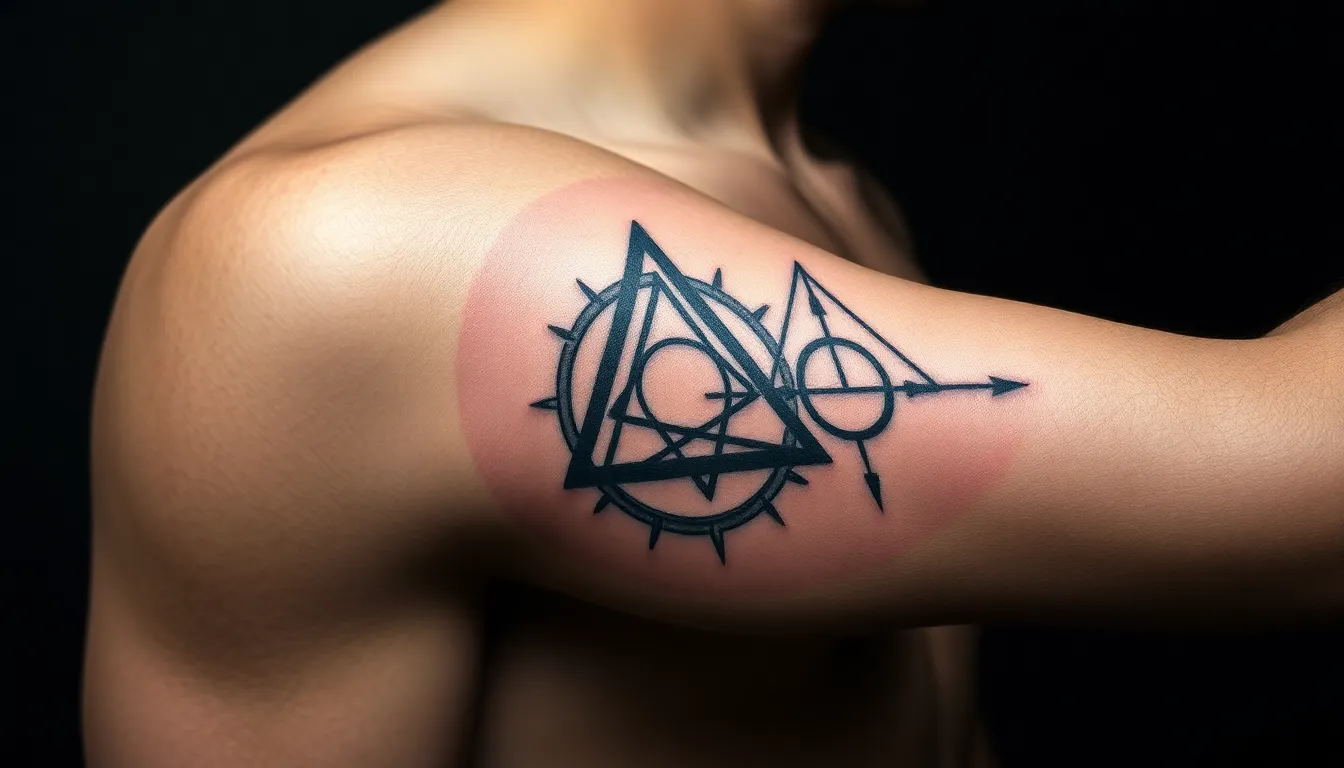
Geometric patterns offer modern men a sophisticated approach to expressing the eternal struggle between light and darkness. These designs combine mathematical precision with profound symbolism to create visually striking tattoos that resonate with contemporary aesthetics.
Sacred Geometry Elements
Sacred geometry forms the foundation of meaningful good and evil tattoos through precisely crafted shapes that represent universal balance. Perfect circles symbolize eternal cycles and completeness, while triangles embody stability and the connection between earthly and divine forces. These fundamental shapes create powerful focal points when contrasted with darker geometric elements.
Combining sacred shapes with opposing forces creates tattoos that speak to the duality within every man. We see triangles pointing upward representing good, paired with inverted triangles symbolizing evil or earthly desires. Sharp angles and clean lines emphasize the tension between these forces while maintaining the minimalist aesthetic that appeals to modern men.
Eye of Horus integration adds ancient wisdom to geometric designs, providing protection and insight through its symbolic power. This Egyptian symbol works beautifully within geometric frameworks, offering both spiritual significance and visual impact. The eye’s natural geometry complements angular patterns while reinforcing themes of resilience and personal insight.
Abstract Light and Dark Contrasts
Abstract contrasts use geometric elements to create visually powerful representations of moral duality without relying on traditional imagery. Black and white wedges create striking visual tension, with each section representing opposing forces in constant struggle. These designs appeal to men seeking modern, thought-provoking body art that makes a bold statement.
Intersecting lines and split circles offer ever-changing ways to show the coexistence of good and evil through geometric forms. We recommend split circles where one half remains solid black while the other stays white or uses negative space. Intersecting lines can create complex patterns that suggest the interconnected nature of opposing forces.
Minimalist execution with maximum impact defines the best abstract geometric tattoos, using precisely lined designs with clean, uncluttered aesthetics. These tattoos emphasize structure and visual clarity through limited color palettes and crisp execution. The contrast between light and dark elements creates powerful visual statements without unnecessary complexity.
Mandala-Inspired Designs
Mandala patterns provide rich opportunities for incorporating good and evil themes through intricate geometric arrangements rooted in spiritual traditions. These circular designs symbolize the universe and life’s cyclical nature, making them perfect canvases for exploring moral duality. Traditional mandala structures can be split between light and dark halves to embody the balance between opposing forces.
Layered mandala interpretations allow for subtle or bold expressions of good versus evil through different design approaches. We suggest creating mandalas with alternating light and dark sections that spiral outward from a central point. This technique creates visual movement while maintaining the symmetrical beauty that makes mandalas so appealing.
Adaptable complexity levels make mandala designs suitable for various minimalist preferences and tattoo sizes. Simple mandala outlines work well for smaller tattoos, while detailed patterns suit larger pieces. The geometric nature of mandalas ensures they maintain their visual impact whether executed as bold statements or subtle accents.
Placement Options for Good and Evil Tattoos on Men

Strategic placement transforms these symbolic designs into powerful statements that reflect both personal meaning and visual impact. We’ll explore the most effective body locations that maximize the artistic potential of good and evil imagery.
Chest and Back Pieces
Chest tattoos offer unparalleled drama for good versus evil narratives. Bold designs flourish across this expansive canvas, with many men choosing split compositions featuring an angel on one side and a demon on the other. The natural symmetry of the chest creates perfect balance for duality themes, allowing each element to command equal visual weight.
Centered designs work exceptionally well for unified good and evil concepts. Religious battles between Archangel Michael and fallen angels gain tremendous impact when positioned over the heart. This placement carries deep symbolic meaning, suggesting the eternal struggle within one’s core being.
Back tattoos provide the largest canvas for detailed good and evil scenes. Winged demons battling celestial beings can spread across the entire back, creating museum quality artwork. Heaven and hell landscapes work particularly well in this location, with intricate details that showcase artistic mastery. Full back pieces allow artists to develop complex narratives that unfold from shoulders to lower back.
Arm and Shoulder Placements
Sleeve tattoos excel at telling unified good and evil stories through connected imagery. Progressive designs can flow from shoulder to wrist, depicting transformation themes or moral journeys. Many men opt for patchwork approaches, combining various good and evil elements into cohesive arm compositions.
Shoulder placements offer versatility for medium sized contrasting symbols. The rounded shoulder muscle provides natural framing for circular designs like yin yang variations or mandala inspired duality concepts. This location works particularly well for men who want meaningful tattoos that remain easily concealable for professional settings.
Half sleeve designs allow for dramatic good versus evil splits. Upper arm placements can feature angelic imagery transitioning into demonic elements, creating powerful visual narratives. The natural flow of arm muscle enhances the movement and energy within these contrasting designs.
Hand and Finger Designs
Hand tattoos make bold statements with high visibility good and evil imagery. Demon faces, angel portraits, or symbolic sigils positioned on hands ensure constant personal reminders of one’s moral duality. These placements require commitment, as hand tattoos remain visible in most professional and social situations.
Knuckle designs work effectively for opposing word pairs or symbols. “GOOD” and “EVIL” across the knuckles create classic contrasts, while symbolic elements like crosses and pentagrams offer subtler approaches. Palm tattoos, though less common, provide unique canvases for intricate good and evil mandalas.
Finger tattoos suit minimalistic good versus evil concepts perfectly. Small crosses, devil horns, or yin yang symbols work well on individual fingers. Ring finger placements often feature wedding band alternatives with good and evil symbolism, representing the balance required in relationships. These subtle designs appeal to men preferring understated approaches to moral duality themes.
Conclusion
Good and evil tattoos represent one of the most powerful forms of masculine self-expression available today. These designs go beyond mere aesthetics to capture the fundamental human experience of moral complexity and personal growth.
Whether you’re drawn to traditional angel and demon imagery geometric abstractions or cultural symbols like yin-yang the key lies in choosing designs that authentically reflect your personal journey. The placement you select will dramatically impact both the visual impact and intimate meaning of your tattoo.
We’ve seen how these tattoos serve as daily reminders of our capacity for both light and darkness encouraging self-reflection and acceptance of our complete nature. They’re not just body art—they’re philosophical statements that grow with us throughout our lives.
The enduring popularity of good and evil tattoos among men proves that this ancient theme continues to resonate in our modern industry offering endless possibilities for meaningful personal expression.
Frequently Asked Questions
What do good and evil tattoos symbolize for men?
Good and evil tattoos represent the internal struggle between one’s better nature and darker impulses. They symbolize the duality of human nature, serving as reminders of personal growth, self-acceptance, and the ongoing battle between light and darkness within every individual.
What are the most popular good vs evil tattoo designs?
Popular designs include angel and demon motifs, yin-yang symbols, split face tattoos, skull and halo combinations, biblical imagery like Archangel Michael versus Lucifer, and geometric patterns. Animal-based designs and abstract light and dark contrasts are also trending choices.
Where should I place my good and evil tattoo?
Strategic placement options include chest and back for dramatic canvases, arms and shoulders for storytelling sleeves, and hands or fingers for bold visibility. The location affects both visual impact and personal meaning, with centered designs often symbolizing internal balance.
Are geometric good and evil tattoos suitable for minimalist preferences?
Yes, geometric designs combine mathematical precision with profound symbolism. They use sacred geometry elements like circles and triangles to represent universal balance and duality. These patterns offer clean, modern aesthetics while maintaining deep spiritual significance for minimalist preferences.
What cultural influences inspire good and evil tattoo designs?
Cultural influences include Christianity’s recognizable good versus evil imagery, Eastern philosophies like Buddhism and Taoism with yin-yang symbols, indigenous traditions, and mythological references from Greek, Norse, and Egyptian cultures. Each tradition offers unique perspectives on moral duality.
How do mandala designs incorporate good and evil themes?
Mandala-inspired tattoos serve as rich canvases for exploring duality themes through layered interpretations. They allow for both subtle and bold expressions of good and evil, using intricate patterns and symbolic elements to represent the balance between opposing forces.
What psychological benefits do good and evil tattoos provide?
These tattoos foster self-awareness and emotional maturity by helping individuals acknowledge and embrace their complete nature. They serve as visual reminders of personal growth journeys and encourage acceptance of both positive and negative aspects of one’s personality.
